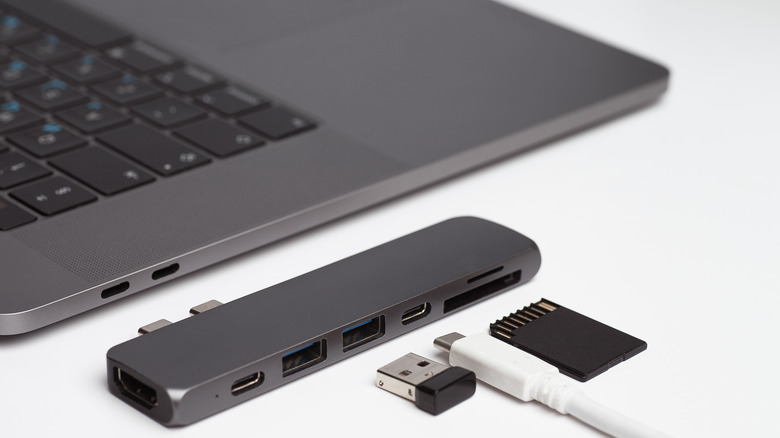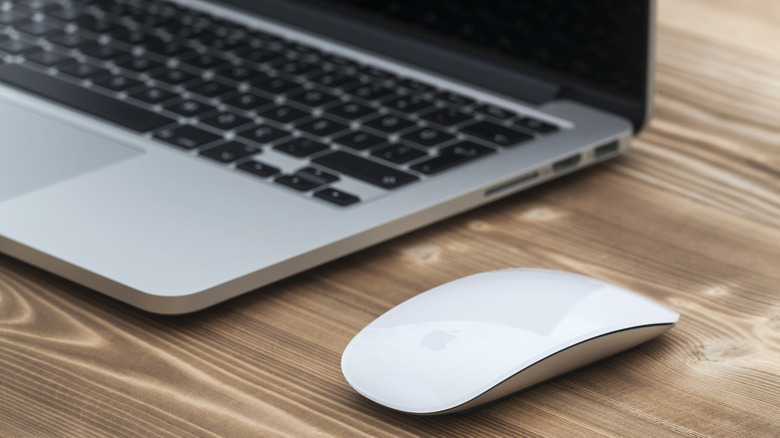6 Essential MacBook Accessories To Check Out In 2024
We may receive a commission on purchases made from links.
When the iPad Pro first debuted, many people wondered if it signaled the beginning of the end for traditional laptop computers. However, it doesn't seem to be the case, as Apple is still clearly putting effort into manufacturing state-of-the-art laptops for those of us not ready (or willing) to transition to tablets. SlashGear reviewed the MacBook Air M3 of Apple's most-recent laptop generation and found it to have a "beautiful design," "top-notch performance metrics," and several other fine points in its favor. Even with a top-of-the-line computer, though, there are accessories available that can enhance your experience with the machine even further.
I've been using a MacBook for over 20 years (technically I was using an Apple PowerBook — the direct ancestor of the MacBook Pro — in college), including various generations of the MacBook Pro and MacBook Air. I'm also a gadget junkie, constantly on the lookout for any type of device, dongle, or doohickey that will make my life even slightly more convenient — this is also why I've been writing about and reviewing tech products for the past few years.
Suffice to say, I've paired many accessories with my MacBook over the years. Some have been totally useless and were a total waste of time and money, while others have been so beneficial that they've more-or-less become permanent extensions of my laptop, even as Apple's hardware and operating systems evolve. Based on my experience, here are six essential MacBook accessories you should check out in 2024.
USB Hub
MacBooks are powerful machines, especially since Apple began using Apple Silicon chips in the M1 MacBooks and later — when SlashGear reviewed the MacBook Pro M1 Max, we called it the "best computer in a decade." However, nearly every MacBook suffers from the same common complaint: not enough ports.
In their ambitious bid to make their laptops as thin and minimalist as possible, there are a lot less ports available on a MacBook than there used to be — especially if you're using a MacBook Air. While my current laptop, a MacBook Pro M3 Pro, includes three USB-C ports and a few other useful additions like an HDMI port and SD card slot, it lacks any USB-A ports. USB-A may be old and less advanced than USB-C, but considering just how many devices still use the standard, not having a native USB-A port on a MacBook can be very frustrating.
Fortunately, a USB hub can quickly solve this situation. These dongles don't take up much space and aren't terribly expensive, especially if you just want a few additional ports. However, if you really want to get the most out of your MacBook, an essential accessory to have is a USB Hub with several varied ports, such as the 7-in-1 dongle I use with my MacBook Air. It connects via a single USB-C port and in exchange provides me with two USB 3.0 ports, one USB 2.0 port, an SD/TF slot, a gigabit Ethernet port, a 4K-capable HDMI port, and a 100W USB-C PD port capable of keeping your computer powered through a wall adapter. Also, available are docks that will attach to the side of your MacBook — often using both USB-C ports — for a more natural extension of your computer, such as the Anker 547 USB-C hub.
Mobile Hotspot
I hope Apple has a really good reason for not offering MacBooks with integrated 5G or LTE connections, because I can't see why it wouldn't. After all, you can get an iPad or iPad Pro with this extremely useful feature, so it doesn't make sense that MacBooks are just available as Wi-Fi only, especially given that portability is kind of its whole thing. If you're working without Wi-Fi, you can use your iPhone as a hotspot for a mobile connection. There are ways to improve your iPhone hotspot, but the connection isn't always great since your smartphone is also running several other apps that rely on the bandwidth. Plus, it could destroy your phone bill if you don't have unlimited data.
That's why an essential MacBook accessory if you're working outside of your home or office is a designated mobile hotspot device, which will use mobile data to provide you with portable Wi-Fi routing capabilities. You can connect your MacBook, phone, and other devices and stay connected as long as you're in range of a cell or 5G tower. Some mobile hotspot devices also double as power banks to keep your devices charged while off the grid. This includes the Solis 5G Hotspot and Power Bank, which can be an essential accessory every digital nomad should have. It can even come with a lifetime subscription of 1 GB of data per month, though — like most mobile hotspots — you can also pay for a monthly subscription to get the mobile data you'll need.
Power Bank and/or Adapter
Apple provides you with a wall adapter when you buy a MacBook, but it might be worth investing in an additional one. For example, I keep one under my desk and another one in my travel bag, so I'm not constantly unplugging and plugging in the former. Plus, I prefer wall adapters with multiple ports (both USB-C and USB-A) — especially when I'm traveling — like the Anker Prime 100W GaN Wall Charger. That way, I can plug it into my hotel room outlet and be able to simultaneously charge my MacBook, iPhone, Apple Watch, and more. You'll want adapters capable of 65W or higher (I go with at least 100W) so that you can power your MacBook and other accessories.
While Apple is continuously improving on MacBook battery life and a new MacBook Pro can last you all day before needing a recharge, batteries tend to become less and less efficient over time. You may also find yourself away from an outlet for an extended period of time, such as when you're traveling. That's why, in addition to a wall adapter, you should have a power bank that can recharge your MacBook when you don't have access to an outlet.
There are plenty of options to choose from when it comes to power banks, such as the Goal Zero Sherpa 100AC and Baseus Blade, which are two of the best portable chargers for laptops available. Just make sure they have the right connector for your MacBook (USB-C or MagSafe 3, unless it's an older model) and that it has enough wattage to power your laptop. The higher the capacity, the more times you can recharge your MacBook while on the go — I strive to carry a 20,000 mAh power bank at a minimum for my computer.
Mouse
Honestly, I prefer to use a trackpad over a mouse — even with desktop computers. But many folks prefer to use a mouse, which isn't hard to pair with a MacBook if you'd like. You can connect a wireless mouse via Bluetooth or employ a corded one using one of your MacBook's USB ports, such as the inexpensive Lenovo 400 USB-C Compact Wired Mouse. Apple fans can also opt for the wireless Magic Mouse, which has a Multi-Touch surface that allows for additional controls.
Another reason you may want a mouse is if you're gaming, which is more convenient than ever since the Apple M3 MAX chip has more GPU cores than the Apple M3 Pro and makes the MacBook a better gaming platform than ever before. In that case, you'll want to make sure you choose the best gaming mouse that's specifically suited for the pastime, like the Razer Viper V3 Pro.
You don't necessarily need a mouse pad when using a mouse, though it often helps, so you may want to add one to your shopping cart if you're accessorizing your MacBook. You can also go with a computer mat — such as the AmazonBasics Large Extended Computer Rectangular Mouse Pad — which is a surface for both your laptop and mouse, as well other accessories. Not only does this give your mouse more space to maneuver, but it can tidy up your workspace (such as by easily collecting crumbs and fingerprints) and make it look more presentable.
Sleeve/Case
MacBooks often don't come cheap, which is why you want to make sure it's well-protected when you travel with it. One option is to use a cover that attaches directly to your laptop, such as the hardshells sold by Incase. I used one of these for years, but with my new MacBook Pro M3, I decided to ditch it and rely solely on a sleeve when traveling. While this exposes my laptop to more scratches, it keeps the computer thinner and doesn't burden the display with extra weight.
The Tomtoc 360 Protective Laptop Sleeve I use provides plenty of cushioned protection for my laptop when I carry it around in my regular backpack — and there are several other quality sleeves that can do the same. These sleeves are often tailored for specific models and sizes — for example, my Tomtoc 360 is fitted for a 14-inch MacBook Pro M3. While you can go with a bigger one, having a sleeve that snugly fits your computer means it won't jostle as much within the pocket and is less prone to impact damage.
You can also opt for a fully dedicated laptop case or backpack, which has a dedicated spot for your laptop with additional protection designed specifically for computers. Some, such as the Razer Rogue 16 Backpack V3 Chromatic, may also provide some waterproof protection against light rain. You can also expect the highest-rated laptop backpacks for school or work to have more designated pockets for cables, dongles, and other accessories than you might find with a regular backpack.
Headphones
Nobody wants to hear your Zoom meetings or job interviews when you're using your MacBook at a local café or other public setting. For the sake of your own privacy, as well as to respect the people around you, you should always use headphones with your laptop if you're not by yourself. Headphones with active noise cancellation (ANC) can be an even better choice, as they can help you focus more on your work. It doesn't matter what kind of headphones you use, as long as they keep the audio low enough so that only you can hear it — you can opt for earbuds, over-the-ear headphones, wrap around, or whatever else suits your fancy.
If there's one thing Apple does well, it's to make its various products work well together. That's why newer Apple headphones can be a very convenient accessory for your MacBook. I use third-generation AirPods, which automatically connect to my laptop as soon as I put one in my ear. The benefits of AirPods — and many of the best Bluetooth headphones — are the built-in microphones that allow you to also use them for calls and video conferences on your MacBook. If you're looking at Apple headphones, there are various pros and cons to consider between the over-ear AirPods Max versus AirPods Pro 2. In SlashGear's review of the Apple AirPods Pro (2022), we noted that if you're not a fan of Apple products, you can skip this hardware. However, if you're looking for an essential audio accessory to your MacBook, they may very well fit the bill.






